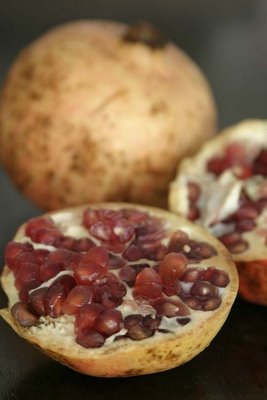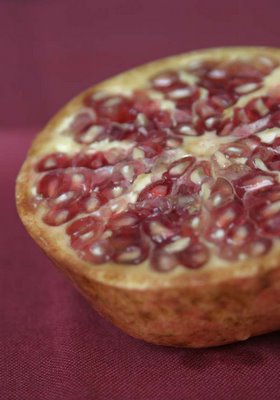
Like everyone else, I love the way a pomegranate looks when it's split into half and its neat cross section of ruby seeds come tumbling out. To be honest, until this week, I couldn't quite remember what a pomegranate tasted like. It's not a fruit you buy to devour, as you would, say, a big juicy Navel orange or a fat, sweet peach. But since I chanced upon a pile of them in the supermarket's fruit section, I decided to pick up a couple and decide what to do with them when I returned home and consulted my cookbooks.

Surprisingly, none of my cookbooks yielded any recipes that featured pomegranates. And so I turned to my pile of Donna Hay magazines and Vogue Entertaining + Travel , where I found several recipes for a couple of cocktails, some salads, and a pretty trifle. Still, in my mind's eye, a beautifully shot picture of some luscious beads of pomegranate seeds atop snow white pavlovas repeatedly came up. And the picture in my vision was shot in a way that just screamed Nigella Lawson. So once again, I pulled out my copy of How To Be A Domestic Goddess , and there it was -- mini pavlovas with those fuschia seeds piled atop them.
As some of you know, I'm always slightly dubious when trying out recipes from the Domestic Goddess book. Sure, several recipes work beautifully; yet others render results so far removed from Nigella's brilliant descriptions of the dish (for example, her brownies and scones) that I now find myself wondering if it's worth the effort to try something new from it. However, I remembered a conversation I had with a friend about this and recalled her saying something about the pavlova recipe working for her. So I casted my doubts aside and jumped in, if anything, because the picture is the book was just so damn gorgeous.

I am happy to report that the recipe was indeed a foolproof one. But alas, this time, the fault lay with my oven. Because I live in a rented apartment, I don't have a "proper" oven - i.e. one of those Miele/Aga numbers that is embedded below the stove and amongst the kitchen cabinets. Instead, I have a smallish DeLonghi freestanding oven that, I must say, has been so good to me over the years. Anyways, because the oven is small, the heat tends to get extremely close to the food in it. Therefore, if a recipe calls for an oven at a temperature of 180 degrees C, I tend to set it at 170 degrees and bake the confection for slightly longer. I made two batches of pavlovas and both of them turned, well, a muted shade of beige -- a hue that looks great on soft furnishings, but not quite flattering on a pavlova. With the second batch, I turned the oven down to about 120 degrees but I still got a batch of light beige discs and thus concluded that the heat in my oven is just way too close for me to ever get pristine white pavlovas that don't fall flat.
Still, the beige pavlovas tasted pretty good and had a wonderfully light texture. So when they cooled, I topped them with a small pillow of unsweetened whipped heavy cream and a handful of pomegranate seeds. Like a mother who finds its hard to see the ugly side of her children, I still thought my beige, white and pink pomegranate pavlova dessert was quite pretty. Perhaps when I, ahem, grow up, and afford my own apartment and kitchen, I'll finally turn out a flawless batch of ivory pavlovas. Till then, these beige ones will just have to do.
No comments:
Post a Comment